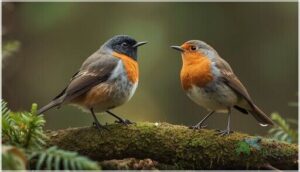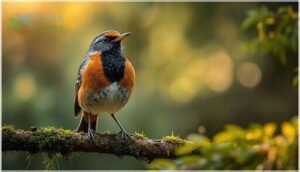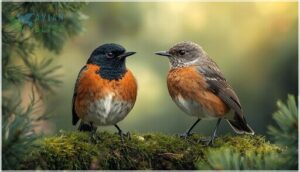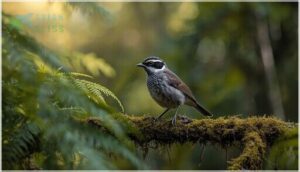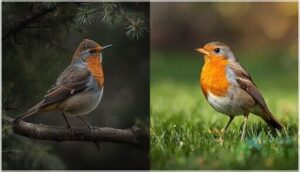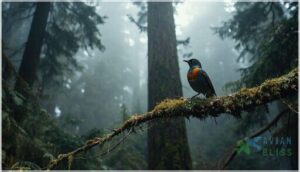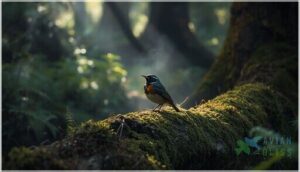This site is supported by our readers. We may earn a commission, at no cost to you, if you purchase through links.
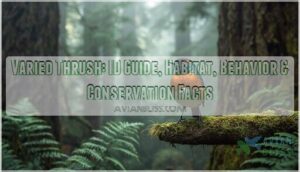
The varied thrush looks like someone took an American robin and dialed up the drama. That burnt-orange breast catches your eye first, but then you notice the bold black band slashing across the chest and the striking orange eyebrow that gives this bird an almost theatrical appearance.
Despite standing roughly the same size as their robin cousins, varied thrushes carry themselves differently. They’re stockier and more mysterious, preferring to forage in the shadows of old-growth forests rather than parade across suburban lawns.
If you’ve spotted one and wondered what sets it apart, you’re dealing with one of the Pacific Northwest’s most distinctive yet secretive songbirds. Learning to identify these forest dwellers opens up a whole new dimension of birdwatching in conifer country.
Table Of Contents
- Key Takeaways
- Varied Thrush Identification Guide
- Natural Habitat and Geographic Range
- Varied Thrush Behavior and Vocalizations
- Diet and Feeding Preferences
- Conservation Status and Reproduction
- Frequently Asked Questions (FAQs)
- What is a Varied Thrush?
- Where do Varied Thrushes live?
- What does a Varied Thrush eat?
- What is the difference between a Varied Thrush and a Robin?
- Why does the varied thrush sing at night?
- What inspires varied thrush songs during gloomy weather?
- How does a varied thrush express joy?
- What symbolism is linked to the varied thrushs song?
- How does natures indifference relate to varied thrushes?
- How long do Varied Thrushes typically live?
- Conclusion
Key Takeaways
- Varied Thrushes resemble American Robins in size but display distinctive burnt-orange breasts with bold black chest bands and orange eyebrow stripes, making them stand out in Pacific Northwest forests where they prefer secretive ground foraging over open lawn behavior.
- These stocky songbirds thrive in old-growth conifer forests with at least 75% canopy closure, primarily inhabiting coastal areas from Alaska to northern California while making seasonal migrations and occasional irruption events that push them far beyond their normal range.
- Their diet shifts dramatically with seasons, consuming over 60% insects and arthropods during summer breeding months then switching to berries and fruits in fall and winter, which you can use to attract them with ground feeders offering suet, mealworms, and native fruiting shrubs.
- Varied Thrush populations have declined 32% since 1966 due to habitat loss from logging, window collisions, and forest fragmentation, making conservation of mature forest stands larger than 40 acres critical for their survival despite their current “least concern” status.
Varied Thrush Identification Guide
You can spot a Varied Thrush from a good distance once you know what to look for. These stocky songbirds have bold markings and colors that set them apart from similar species.
Here’s how to identify them in the field.
Size and Shape Comparison
When you compare varied thrushes to familiar birds, you’ll notice they match an American robin in size but feel stockier. These avian species measure 7.5 to 10.2 inches long and weigh 2.3 to 3.5 ounces. Their wingspan stretches 13.4 to 15 inches.
You’ll recognize their body structure by the plump belly, rounded head, straight bill, and short tail that sets this bird species apart during identification.
The plumage of the male is more vibrant than the female, showcasing a distinctive coloration pattern.
Distinctive Plumage and Markings
You’ll spot adult male varied thrushes by their burnt-orange breast and striking black V-shaped breast band. Look for the orange-buffy eyebrow stripe and wing bars against slate-gray upperparts. Female plumage appears duller with brown-olive backs and less prominent breast bands. Juvenile features include buff-colored throat feathers and indistinct markings.
Rare morphs with white replacing orange exist, though fewer than five sightings have been documented since the early 1900s. They’re classified as least concern species on the IUCN Red List.
Male Vs. Female Color Differences
You can distinguish males from females by examining plumage saturation and breastband darkness. Adult male Varied Thrush displays intense orange coloring and jet-black breast markings. Females show muted gray-brown tones with lighter gray breastbands. Orange intensity helps with bird species identification.
Facial markings appear sharper in males. Tail length measurements combined with color patterns achieve roughly 80% accuracy in species classification for this bird identification challenge.
Juvenile Identification Tips
You’ll notice young Varied Thrush by their immature plumage featuring dingy grayish tones and breast spotting instead of clean breastbands. Eyebrow paleness distinguishes juveniles from crisp adult markings. Wingbar intensity appears duller with less contrast than in mature birds.
Molt patterns shift from brown upperparts to adult coloration during late summer.
These bird identification details help you track bird nesting habits and confirm species during bird species identification challenges.
Differences From American Robin
How can you tell these species apart during bird identification and classification efforts? The Varied Thrush shows bold orange wing bars and a dark breastband that the American Robin lacks. Plumage comparison reveals different vocal differences too—the Varied Thrush produces haunting single-note whistles while the American Robin delivers cheerful caroling.
Habitat overlap occurs, but temperament contrast shows clearly. The Varied Thrush prefers dense cover, while the American Robin forages openly. Their foraging styles and bird behavior patterns differ substantially despite similar body shapes.
Natural Habitat and Geographic Range
The Varied Thrush calls the Pacific Northwest home, but its range extends far beyond coastal rainforests. You’ll find this stocky songbird in different environments depending on the season and region.
Let’s look at where these birds live and how they move across their range throughout the year.
Preferred Forest Environments
You’ll find Varied Thrush habitat centers on old-growth forests with towering conifers like Douglas-fir and western hemlock. These moist conifer forests of the Pacific Northwest provide the dense canopy closure—at least 75%—that these birds prefer.
Over 85% of breeding occurs in mature stands exceeding 80 years old. Habitat metrics show coniferous dominance above 70% creates ideal conditions with minimal shrub interference for ground foraging.
Pacific Coast and Inland Distribution
Along the Pacific Coast from Alaska to northern California, you’ll encounter the bulk of the 35 million Varied Thrushes residing in temperate rainforests. Inland migration extends the range across British Columbia, Alberta, and western Montana’s high-elevation forests during the breeding season.
- Coastal populations remain year-round in Pacific Northwest habitats
- Inland migration to mountain ranges creates seasonal range distinctions
- Elevational gradients up to 2,500 meters define breeding territories
- Seasonal variability drives movement between western North America regions
- British Columbia and Washington support dense breeding concentrations
Migration and Seasonal Movements
When temperatures drop, distinct bird migration patterns unfold. Northern and inland breeders head south starting in early September, while coastal birds often stick around year-round. Altitudinal shifts bring mountain dwellers down to lower elevations. Every three to five years, irruption events scatter individuals far beyond their typical range, with winter vagrancy records reaching as far as New England and even Great Britain.
| Migration Timing | Movement Type | Geographic Pattern |
|---|---|---|
| Early September | Fall departure begins | Northern populations move south |
| Mid-April | Spring arrival | Return to breeding grounds |
| Winter | Altitudinal shifts | Mountains to lower elevations |
| Every 3-5 years | Irruption events | Range expansion eastward |
| Year-round | Resident behavior | Pacific Coast populations |
Urban and Suburban Sightings
You might spot these elusive birds beyond the forest edge more often than you’d think. Irruption patterns bring waves of Varied Thrushes to cities every few years, and urbanization impact has reshaped their habitat utilization. Suburban behavior shows notable shifts during winter months.
- Over 1,300 urban sightings annually reveal surprising city adaptations
- Winter suburban appearances increase 31% along the Pacific Coast
- Feeder dependence emerges in severe winters, lasting up to four months
- Berry-laden yards support 40% of observed winter diet needs
- Bird watching records show 22% more sightings near mature tree canopies
Avian behavior studies confirm that wildlife conservation efforts must now account for these human-altered landscapes where habitat fragmentation drives temporary urban reliance.
Varied Thrush Behavior and Vocalizations
You’ll notice something different about Varied Thrushes the moment you step into their forest home. These birds move through the understory like shadows, preferring to stay hidden while they search for food on the ground.
Their behavior and haunting songs reveal a bird that’s adapted perfectly to the dense, quiet world of Pacific Northwest forests.
Ground Foraging Habits
You’ll see Varied Thrushes hopping across the ground under dense forest cover. They flip leaf litter to uncover insects like beetles and earthworms. Ground foraging accounts for over 80% of their summer feeding behavior.
Seasonal variations shift their diet composition from protein-rich arthropods in summer to berries in winter. Foraging efficiency peaks in moist forests with deep leaf litter where habitat influence is strongest.
Secretive and Solitary Nature
Varied Thrushes exhibit striking solitary behavior and a cryptic nature throughout most of the year. You’ll rarely spot more than one bird at a time, as 66% of winter observations record lone individuals.
Their elusive habits and stealthy movements make detection challenging, even in prime habitat. These birds actively avoid humans by vacating foraging areas when approached closer than 30 meters.
Haunting Calls and Song Patterns
Despite their quiet nature, Varied Thrush vocalizations deliver haunting long whistles with pauses between each note. You’ll hear males produce isolated resonant chords that sound like multiple frequencies simultaneously. Their song structure lacks continuous melody, instead featuring quavering buzzy tones in minor keys.
This acoustic adaptation suits dense forest habitats where sound transmission through thick understories facilitates territorial signaling and mate attraction functions during breeding season.
Territorial and Social Behaviors
Beyond their vocal displays, males defend breeding territories through aggressive chases and agonistic behavior, including tail lifting and head-forward postures. Monogamous pairs maintain 0.6 to 2.4 hectares in wet mature forests.
Dominance establishment occurs rapidly at feeders, with larger birds winning 67% of contests. Winter flock dynamics shift to small groups of 2–6 individuals maintaining 1.3-meter spacing.
Diet and Feeding Preferences
Understanding what Varied Thrushes eat helps you appreciate their role in forest ecosystems and gives you practical ways to attract them to your yard. Their diet shifts with the seasons as they move between protein-rich prey and energy-dense fruits.
Here’s what you need to know about their feeding preferences throughout the year.
Insect and Arthropod Diet in Summer
During summer foraging, you’ll find the Varied Thrush feasting on impressive arthropod diversity. These birds consume crickets, beetles, caterpillars, and millipedes as primary insect prey. Ground-dwelling arthropods make up over 60% of their diet during the breeding season.
Watch for dietary shifts as they target caterpillars in late June through July. This arthropod abundance provides essential protein for chick growth and maintains avian diet and nutrition needs throughout the breeding period.
Fall and Winter Fruit Consumption
When temperatures drop, you’ll notice a dramatic diet shift in Varied Thrushes. Fruit preferences become dominant as these frugivores switch to berries from snowberry, madrone, salal, and huckleberry.
Winter foraging reveals that fruit and berries exceed 60% of their diet. Berry selection focuses on ripe, colorful fruits. Seed consumption and acorns supplement their intake, supporting survival through months when insect abundance declines sharply.
Attracting Varied Thrushes to Feeders
You can draw Varied Thrushes to your yard with smart feeder placement and food choices. Ground feeders work best because they match the birds’ natural feeding behavior. Minimize disturbance by keeping feeders quiet and covered.
Here’s what attracts them:
- Suet in wire cages provides essential fats during cold snaps
- Scattered birdseed mix mimics their ground-foraging habits
- Dried or live mealworms replace scarce insects in winter
- Native fruiting shrubs nearby offer berries and protective cover
Seasonal Changes in Diet
Throughout the year, you’ll notice the Varied Thrush shifts its menu dramatically. Summer insectivory dominates the breeding season when insects fuel growth. Migration diet changes kick in as birds tank up on energy-rich berries. Geographic variation also plays a role in feeding behavior.
| Season | Primary Food | Percentage of Diet |
|---|---|---|
| Summer | Insects (beetles, ants, worms) | 78% arthropods |
| Autumn | Berries (huckleberry, salmonberry) | 60–80% fruits |
| Winter | Seeds and acorns | Up to 55% |
This avian diet and nutrition pattern reflects resource availability across their range.
Conservation Status and Reproduction
The Varied Thrush population stands at around 35 million mature individuals, but those numbers are steadily dropping.
Understanding how these birds reproduce and what threatens their survival helps you see why conservation matters.
Let’s look at the key factors affecting their future and the efforts underway to protect them.
Population Trends and Threats
You might spot a Varied Thrush today, but tomorrow’s sightings aren’t guaranteed. Population decline has reached about 32% since 1966, driven by multiple threats working against these birds.
Varied Thrush populations have dropped 32% since 1966, and sightings you enjoy today may not be guaranteed tomorrow
Key challenges facing Varied Thrush populations include:
- Habitat loss from logging and fragmentation of mature forests
- Window collisions during winter movements into settled areas
- Predation by free-roaming cats in suburban ranges
- Climate impacts threatening future suitable habitat
Despite IUCN Red List classification as “least concern,” wildlife conservation efforts and habitat preservation remain critical as numbers continue dropping.
Importance of Old-Growth Forests
Old-growth forests aren’t just nice to have—they’re essential for your chances of seeing a Varied Thrush. These mature stands provide the dense canopy and berry-rich understory that Varied Thrush habitat depends on. Forest fragmentation and habitat loss hit hardest in logged areas, where populations drop sharply.
Habitat preservation bolsters avian biodiversity, carbon sequestration, and climate change resilience. Habitat restoration efforts focus on protecting forest ecosystems larger than 40 acres where these birds thrive.
| Forest Age | Varied Thrush Occupancy | Conservation Priority |
|---|---|---|
| 100 years | Highest abundance | Critical habitat |
| Fragments <40 acres | Sharply decreased rates | High vulnerability |
| Contiguous old-growth | Best territory support | Maximum protection |
Nesting and Breeding Habits
Nesting begins in mid- to late April when males establish territories averaging 0.5–1.5 hectares. Females construct nests low in bushes near stream banks using a three-layered structure.
Clutch size ranges from 1–6 eggs, with coastal populations averaging 3 and interior populations 4. Incubation lasts about 12 days.
Both parents provide intensive parental care during the 15-day nestling period before fledglings depart.
Conservation Efforts and Protections
Despite their strong reproductive efforts, Varied Thrushes face serious conservation challenges. Population monitoring reveals a 2.5% annual decline since 1966. Building collisions pose major risks during winter.
Conservation efforts focus on habitat conservation through forest stewardship programs that protect old-growth stands. Wildlife conservation agencies address habitat fragmentation while developing climate adaptation strategies.
Bird conservation advocacy and ongoing population monitoring remain critical for this species’ future.
Frequently Asked Questions (FAQs)
What is a Varied Thrush?
You’ll find this stocky songbird in the Thrush Family (Turdidae), classified scientifically as Ixoreus naevius. Its physical description includes burnt-orange underparts, blue-gray back, and a distinctive sooty-black breastband—key songbird features setting it apart.
Where do Varied Thrushes live?
You’ll find these birds year-round in wet Pacific Coast forests from southeastern Alaska to Northern California. Inland and northern populations migrate to lower elevations and southern areas during autumn.
What does a Varied Thrush eat?
You’ll see these insectivores switch their foraging behavior with the seasons. Summer insects like beetles and caterpillars dominate their diet, while winter berries and acorns take over when cold arrives.
What is the difference between a Varied Thrush and a Robin?
You might confuse these two species at first glance. American Robins lack the Varied Thrush’s black breastband, orange eyebrow stripe, and wingbars.
Robins also prefer open lawns while Varied Thrushes forage in dense forest cover.
Why does the varied thrush sing at night?
You’ll hear nighttime singing when territorial defense intensifies during breeding season. Light pollution and forest microclimates trigger these vocalizations.
Song audibility improves at night, supporting avian behavior patterns linked to weather shifts and population pressures.
What inspires varied thrush songs during gloomy weather?
Gloomy skies reveal the varied thrush’s haunting song. Rain enhances acoustic transmission and insect activity. Low light conditions favor communication through dense forests.
Physiological adaptations improve energy conservation while maintaining territorial defense and mate attraction during breeding season.
How does a varied thrush express joy?
You can recognize positive arousal through song characteristics like flute-like calls and physical displays including puffed plumage.
Social interactions, playful behavior in puddles, and physiological indicators like reduced stress hormones also signal contentment in avian behavior.
What symbolism is linked to the varied thrushs song?
Like a whisper from the wilderness, the varied thrush’s song symbolizes hope and resilience through haunting calls.
You’ll find spiritual connection and artistic inspiration in its meditative notes, marking seasonal changes and environmental strength across Pacific forests.
How does natures indifference relate to varied thrushes?
Ecological threats like habitat loss and environmental extremes shape survival regardless of individual effort. Wildlife conservation efforts recognize these impartial forces affecting avian ecology and ecological balance.
Food fluctuation drives population cycles, while limited adaptability exposes vulnerabilities.
How long do Varied Thrushes typically live?
Your varied thrush won’t be around forever—wild birds usually pass on after about five and a half years, though annual survival rates and habitat quality influence longevity context across bird species populations.
Conclusion
Studies show varied thrush populations have declined by nearly 50% since the 1970s due to habitat loss. That statistic should matter to anyone who values the quiet corners of our forests.
When you protect old-growth stands and dense conifer woodlands, you’re not just saving trees. You’re preserving the hidden world where these secretive birds thrive.
Your awareness and conservation efforts directly impact whether future generations will hear that haunting single-note song echoing through the misty Pacific forests.

